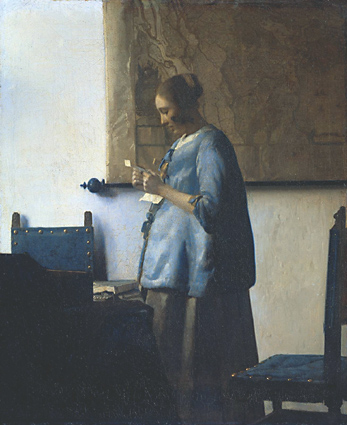On the eve of the feast day of St Margaret, patron saint of pregnant women, this week’s picture is Johannes Vermeer’s beautiful, becalmed depiction of an evidently expectant mother: Woman in Blue Reading a Letter, which can be seen in The Rijksmuseum in Amsterdam.
Nowadays Vermeer is a household name but for almost two hundred years after his death in 1675 his reputation fell into neglect. It was only in the second half of the nineteenth century that he was suddenly elevated into the pantheon of the world’s great artists. A letter written in the summer of 1888 by Vincent Van Gogh to his friend Emile Bernard perfectly captures the sense of dawning excitement which attended the rediscovery of Vermeer’s quiet and self-effacing genius. Van Gogh was musing on the power of art to preserve a moment of beauty and blessedness forever, when his thoughts turned to the picture reproduced on this page:
“… a complete thing, a perfection, renders the infinite tangible to us; and the enjoyment of a beautiful thing is like coitus, a moment of infinity. For instance, do you know a painter called Vermeer who has painted, among other things, a very beautiful pregnant Dutch lady? The palette of this strange painter is blue, citron yellow, pearl grey, black, white … as characteristic of him as black, white, grey and pink are of Velazquez.”
This strikes me as one painter’s intuition about another that goes straight to the heart of his work. Vermeer certainly does seem strange, or at least exceptional, by comparison with his contemporaries. Reticence is one of his distinguishing features. Almost every other Dutch genre painter seems, by contrast, irritatingly over-eager to explain the meaning of his pictures, to tell a clear story or point an obvious moral. Scenes of women...


